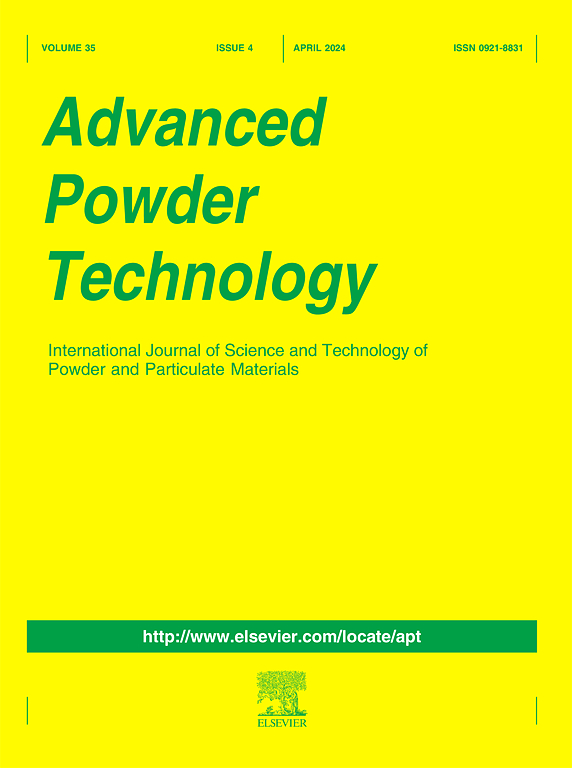Innovative separation strategies for low-rank coal flotation: Filling self-generated pores with gutter oil collectors to enhance hydrophobic sites
IF 4.2
2区 工程技术
Q2 ENGINEERING, CHEMICAL
引用次数: 0
Abstract
Low-rank coal (LRC) has strong hydrophobicity, which leads to low efficiency in conventional flotation that coal particles need to be mixed with water first, making it difficult for collector molecules to replace water molecules. An innovative technology for microwave heating to remove moisture and dry adsorption of gutter oil collectors was proposed to make the collectors efficient in adsorbing on coal surface. Firstly, the particle morphology and phase composition of LRC were analysed through SEM and XRD to clarify the impact of particle morphology and mineral composition on floatability. Furthermore, the functional group composition and hydrophobic group content of the modified LRC were analysed by FTIR and XPS, respectively. Contact angle analysis and wrap angle analysis were used to investigate the stability of particle-bubble adhesion. Finally, flotation experiments and flotation kinetics analysis were conducted to verify the flotation characteristics of modified LRC. The SEM analysis results indicate that the high porosity of LRC can intercept more water and form a thick water film. The XPS analysis results indicate that the content of hydrophobic groups in LRC is only 61.69 %, which is the core reason why it is difficult for LRC to float. The content of hydrophobic groups C–C/C–H in modified LRC increases to 86.05 % after collector adsorption. In addition, the contact angle increases from 13.71° to 74.63°, further improving the adhesion stability between LRC particles and bubbles, while the wrap angle increases from 18° to 131° for 0.5–0.25 mm. Compared to raw coal, the combustible recovery of modified LRC increases from 23.13 % to 66.89 % with a collector dosage of 9000 g/t. The flotation kinetics results demonstrate that the flotation characteristics of various particle sizes of modified LRC have been significantly improved. Research provides an innovative and sustainable way to improve the flotation efficiency of LRC.

低阶煤浮选的创新分离策略:用地沟油收集器填充自生孔隙以增强疏水部位
低阶煤(LRC)具有较强的疏水性,导致常规浮选时煤颗粒需先与水混合,效率较低,捕收剂分子难以替代水分子。为了提高地沟油集热器在煤表面的吸附效率,提出了一种微波加热除湿干燥吸附技术。首先,通过SEM和XRD分析了LRC的颗粒形貌和物相组成,明确了颗粒形貌和矿物组成对可浮性的影响。并用FTIR和XPS分析了改性LRC的官能团组成和疏水性基团含量。采用接触角分析和包裹角分析对颗粒-气泡黏附的稳定性进行了研究。最后进行了浮选实验和浮选动力学分析,验证了改性LRC的浮选特性。SEM分析结果表明,高孔隙率的LRC能截留更多的水,形成较厚的水膜。XPS分析结果表明,LRC中疏水性基团的含量仅为61.69%,这是LRC难以浮起的核心原因。经捕收剂吸附后,改性LRC疏水基团C-C / C-H的含量提高到86.05%。此外,接触角从13.71°增加到74.63°,进一步提高了LRC颗粒与气泡之间的粘附稳定性,而包裹角从18°增加到131°,为0.5-0.25 mm。与原煤相比,当捕收剂用量为9000 g/t时,改性LRC的可燃回收率由23.13%提高到66.89%。浮选动力学结果表明,改性LRC在不同粒径下的浮选特性均有显著改善。研究为提高LRC浮选效率提供了一条创新和可持续的途径。
本文章由计算机程序翻译,如有差异,请以英文原文为准。
求助全文
约1分钟内获得全文
求助全文
来源期刊

Advanced Powder Technology
工程技术-工程:化工
CiteScore
9.50
自引率
7.70%
发文量
424
审稿时长
55 days
期刊介绍:
The aim of Advanced Powder Technology is to meet the demand for an international journal that integrates all aspects of science and technology research on powder and particulate materials. The journal fulfills this purpose by publishing original research papers, rapid communications, reviews, and translated articles by prominent researchers worldwide.
The editorial work of Advanced Powder Technology, which was founded as the International Journal of the Society of Powder Technology, Japan, is now shared by distinguished board members, who operate in a unique framework designed to respond to the increasing global demand for articles on not only powder and particles, but also on various materials produced from them.
Advanced Powder Technology covers various areas, but a discussion of powder and particles is required in articles. Topics include: Production of powder and particulate materials in gases and liquids(nanoparticles, fine ceramics, pharmaceuticals, novel functional materials, etc.); Aerosol and colloidal processing; Powder and particle characterization; Dynamics and phenomena; Calculation and simulation (CFD, DEM, Monte Carlo method, population balance, etc.); Measurement and control of powder processes; Particle modification; Comminution; Powder handling and operations (storage, transport, granulation, separation, fluidization, etc.)
 求助内容:
求助内容: 应助结果提醒方式:
应助结果提醒方式:


